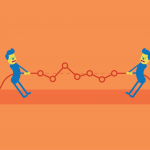
Just over a decade ago (while on a sabbatical) I was as a enjoying my time as a personal trainer in Vancouver, working one-on-one with some sensational people, building their strength and helping them achieve their physical goals.
It was great fun and very rewarding. I often reflect back on that time and consider what I learned during that time that I can apply today. Many of my clients were very accomplished business leaders and working closely with them and pushing them to their limits, safely, gives you great insights.
One of the clearest learnings I have from this time is the way each of these people knew their strengths and went out of their way to shape their work and working lives around them. They had each exploited significant opportunities and were doing well in business and in life. Seriously, you had to be doing very well to train at this studio.
The most simple of these decisions came from Mike. Mike was and is still a legend. Hard working, passionate and fiercely loyal. Mike would always tell you if you were not performing or if he was not hitting the goals he expected.
Mike also did not like to train in the morning.
I had always thought this excuse was a cop out, but to oblige me, one week he trained only in the morning and his body just did not want a bar of it. As much as Mike tried to bring his usual intensity, he fatigued unusually quickly and disengaged shortly after.
Once we changed his training back to evenings, Mike and I had a conversation about the merits of shaping our lives around our strengths, both for work and play. That discussion really resonated with me. As someone who always wanted to demonstrate my ability to work well in all situations, I understood that changing my own approach and recognising the opportunity to focus on strengths could make a huge difference.
The interesting thing to ponder is how this translates to a corporate environment. Many things in your working life are open to tweaking, but you have to be aware enough to know what they are and how to make them work better for you.
The workplace is changing and more and more there are opportunities for people to shape or at least influence how they interact with their working environment.
Whether you are working from home, in an office, travelling or working across a network of offices, both the physical surroundings and the way that you plan your schedule and interactions are potentially open to adjustment.
After decades of having the elements of the working environment dictated to us, it can actually come as a surprise to think that you can change the environment and the construction of your day to work better for you.
For me, there are four elements that, if manipulated to your own strengths, can make a huge difference to your working life.
- Timing is everything
Just like Mike, we all have physical and mental attributes that mean we are better or worse at things depending on the time of day. This means, you need to think hard about what tasks are best to do throughout the day and equally, you can apply the same thinking to a typical week. Some of us take a whole day to warm up on Monday and by Friday we are flat out working hard for the weekend. With this in mind, mapping out your day based on your abilities can ensure that you have the right energy, composure and information to tackle your biggest priorities most effectively.
A good way to look at this is to keep a diary and note your abilities during your activities for a few weeks. Be careful to note the positives and negatives you encounter and start considering how they relate to the setting, your alertness, your own style and the sequence of events. Once you do this you may be able to have a creative look at your schedule and see what may be modified to give you more confidence based on your learnings.
One of my old bosses used to talk about getting the right rhythm as a team to deliver in busy times. She called it getting the right “Battle Rhythm”, which involved being able to meet the everyday demands of the project while having enough in reserve to deal with unplanned spikes.
The idea here is that if you can establish a reliable rhythm, you can plan around that and understand where the potential tipping points may be and where backup is required. If you can find a consistent tempo in the way you schedule your events and efforts, you may realise some confidence and results you did not know were possible.
The strange thing is that not everyone understands that there is a level of choice in how we work and while we can’t always change our meeting schedule or change what’s assigned to us, we can think about the best way to warm ourselves up for a task or schedule down time to clear our minds. Just like a track athlete doing some warm up runs before their main event at the Olympics, your brain may just need that warm up before you launch into your most important tasks.
- Leveraging your style
Anyone who has done any level of personality profiling would understand how much this can improve the way you in engage with your people, environments or situations.
Understanding your innate traits and your likely response to situations and engagements, based on these traits can provide a vast amount of intelligence towards shaping the best work environment for you.
Style and your working space
Any reasonable analysis of your personal style will help you understand how your working environment is best constructed. Some people like to have some isolation to help them think, others like to be amongst the people as they thrive on contact, feedback and collaborative work. Others want a bit of both. The key element here is understanding what the best situation is and trying to shape your space around that.
For example, I know what works for me and I can see a real difference when I get it right. I love constant contact, I love to be around people, understand their challenges and contribute to solving their problems. I wouldn’t say I am an extrovert, but I always do better around people and hence my goal is to be well entrenched in a team situation as often as possible.
I know heaps of people that see this differently and they prefer to have space, they hate open-plan settings and they want everyone to go about their business in isolation. The important thing is to understand your best environment and how you can leverage this to make your day productive.
Style and your engagements
Having a strong awareness of both your own and your team’s engagement preferences will position you well to plan and execute high quality interactions. The elements to consider in an interaction include the type of language, speed or tempo, the structure and the level of detail. Some analytical and assertive colleagues will want to cut to the chase, focus on outcomes and key indicators and move quickly, whereas more intuitive people may feel more comfortable in speaking broadly first and taking logical steps towards an agreed outcome with an easy pace.
The most important thing to recognise is the differences between you and your colleagues and how these contrasts may cause unnecessary conflicts. Taking the time to prepare for key interactions or modify your own style to align to whoever you are engaging with can pay big dividends and again, make your work a bit more enjoyable and productive.
- Connecting to value
We all know that we are driven by value, not just in a commercial sense, but also by tasks and outcomes that align to our own sense of what is right and what will make a difference. For example, I like to make a big contribution and I get a big kick out of helping others solve their problems.
If you look at the work of David Rock with his SCARF Model or Dr Marie Guzman and her work in Neuroscience and change, we know that for people to be able to make a change they must see value and that must serve as their motivator to follow through with the effort.
Change, as in working hard to make a difference and achieve an outcome, takes energy and our brains are wired in a way that maintains the status quo to avoid spikes in energy output and retain control. Seth Godin’s discussion of the “Lizard Brain” in the book “Linchpin” also identifies how our survival-focused behaviours driven by the pre-historic “Lizard-brain” will shoot down the innovative and artistic possibilities that we seek in favour of a known, reliable and repeatable action that requires less risk and uses less energy.
So, in a work sense, you need to understand what motivates you and how you can frequently connect with this throughout your day. Keeping yourself tuned into this value will help maintain the positive mindset that can make work more enjoyable as well as productive.
- Picking your battles
As Seth Godin also says in “Linchpin”, there is great wisdom in understanding what you have the power to change versus what will be a poor use of your energy. Just like Mike, who knew he could not bring his physical A-game to the morning training sessions, recognising what can and can’t be changed can empower us to quickly focus on where we can kick the biggest and best goals.
Godin’s theory links this selection to an ability to “ship” (deliver an outcome) on time and on budget as the paramount part of your effort. He recommends “trashing” early to make the hard decisions about what is in and what’s out of the project and then shutting down the distractions and committing all energy to producing a great product and shipping it on time.
Wrap up
I am grateful to Mike for the lesson that he provided and I hope this perspective can help make a difference for you.
These four steps can help you build a foundation for improving your work setting and no doubt there will be many more that you can identify once you master using your awareness and analysis to shape your surroundings.
Like Neo in the move “The Matrix”, you will find that there are many forces that tend to try and maintain the status quo, but if you can figure out the tweaks that support your work strengths, you stand a better chance of achieving your goals and empowering your teams.
Want to know more? Want to challenge my thinking? Drop me a note on benjamins@stockwellbretton.com






